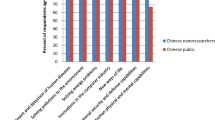Abstract
The experience with genetically modified foods has been prominent in motivating science, industry and regulatory bodies to address the social and ethical dimensions of nanotechnology. The overall objective is to gain the general public’s acceptance of nanotechnology in order not to provoke a consumer boycott as it happened with genetically modified foods. It is stated implicitly in reports on nanotechnology research and development that this acceptance depends on the public’s confidence in the technology and that the confidence is created on the basis of information, education, openness and debate about scientific and technological developments. Hence, it is assumed that informing and educating the public will create trust, which will consequently lead to an acceptance of nanotechnology. Thus, the humanities and social sciences are seen as tools to achieve public acceptance.
In this paper, the author argues that this is a narrow apprehension of the role of the humanities and social sciences. The humanities and social sciences have a critical function asking fundamental questions and informing the public about these reflections. This may lead to scepticism, however, the motivation for addressing the social and ethical dimensions of nanotechnology should not be public acceptance but informed judgement. The author illustrates this critical function by discussing the role, motivation and contribution of ethics as an example. Lastly, the author shows that a possible strategy for incorporating the humanities and the social sciences into nanotechnology research and development is Real-Time Technology Assessment, where the purpose is to integrate natural science and engineering investigations with ethical, legal and social science from the outset.
Similar content being viewed by others
Notes
Research and Development (R&D).
National Nanotechnology Initiative (NNI)
Nanotechnology, Biotechnology, Information Technology and Cognitive Science (NBIC).
An example of an interdisciplinary nanotechnological research network is the Frontiers Network of Excellence funded by EU’s Sixth Framework Programme. The network consists of 12 partners from all over Europe researching into physics, chemistry, materials science, electronics, molecular biology, and health sciences. To integrate the social sciences and the humanities in the interdisciplinary network, it is stressed that a sociologist and an ethicist are part of the network. At Cambridge University, which is one of the partners, the sociologist Robert Doubleday had a post doctoral position until year 2006. He has a background in chemistry and sociology. The University of Aarhus, which is also a member of the network, has employed an ethicist, Mette Ebbesen, who has degrees in molecular biology, philosophy, and ethics.
Over past decades, participatory consensus conferences have spread internationally in an attempt to prevent societal conflicts over controversial technologies. The model of participatory consensus conferences—widely referred to as “the Danish Model” was originally developed by The Danish Board of Technology in the mid-1980s. Researchers point out that evaluations of such conferences seem to rest on the assumption that this type of procedure has universally agreed goals and meanings and that therefore consensus conferences can readily be interpreted and applied across national boundaries [26]. However, Nielsen et al. [26] investigated three consensus conferences on GMOs which took place in France, Norway and Denmark and concluded that interpretations of the concept of participation, the value attributed to lay knowledge versus technical expertise, ideas about the role of laypersons as well as what role public participation would be allowed to play in a democratic society vary considerable from country to country. Hence, the model of consensus conferences needs to be interpreted in the context where it is to be implemented.
References
Roco MC (2003) Broader societal implications of nanotechnology. J Nanopart Res 5:181–189
National Science and Technology Council, USA (1999) Nanotechnology research directions: IWGN workshop report. In: Roco MC, Williams S and Alivisatos P (eds) Vision for nanotechnology research and development in the next decade
Ministry of Science, Technology and Innovation (2004) Technology foresight on danish nanoscience and nanotechnology
European Commission (2004) Towards a European strategy for nanotechnology
Royal Netherlands Academy of Arts and Sciences (2004) How big can small actual be? Study Group on the Consequences of Nanotechnology
National Science Foundation (NSF) (2001) Societal Implications of Nanoscience and Nanotechnology. Report of a workshop run by NSF, 28–29 September 2000. Roco MC (eds) Bainbridge WS
European Commission (2004) Science and society action plan
European Commission (2003) Europeans and biotechnology in 2002. Eurobarometer 58.0
Williams-Jones B (2004) A spoonful of trust helps the nanotech go down. Health Law Rev 12(3):10–13
Marris C (2001) Public views on GMOs: deconstructing the myths. Stakeholders in the GMO debate often describe public opinion as irrational. But do they really understand the public. EMBO Rep 2(7):545–548
Sjoeberg L (2004) Principles of risk perception applied to gene technology. EMBO Rep 5:S47–s51
Gaskell G, Allum N, Bauer M, Jackson J, Howard S, Lindsey N (2003) Climate change for biotechnology? UK Public Opinion 1991–2002. Agbioforum 6(1&2):55–67
Lassen J, Jamison A (2006) Genetic technologies meet the public. Sci Technol Human Values 31(1):8–28
Tveit GK, Madsen H, Sandoe P (eds) (2003) Biotechnology and the public. Danish Centre for Bioethics and Risk Assessment
NSF/DOC (2002) Converging technologies for improving human performance, nanotechnology, biotechnology, information technology and cognitive science. NSF/DOC-sponsored report. Roco MC, Bainbridge WS (eds), pp ix–x
Ebbesen M, Andersen S, Besenbacher F (2006) Ethics in nanotechnology: starting from scratch? Bull Sci Technol Soc 26(6):451–462
Rickerby DG (2004) Risks and ethical challenges of nanotechnology in healthcare. In: Nanotechnologies: a preliminary risk analysis on the basis of a workshop 1–2 March 2004 European Commission, pp 127–131
Robison W (2004) Nano-ethics. In: Baird D, Nordmann A, Schummer J (eds) Discovering the Nanoscale. IOS, Amsterdam, pp 285–301
Gorman ME (2004) Societal dimensions of nanotechnology as a trading zone: results from a pilot project. In: Baird D, Nordmann A, Schummer J (eds) Discovering the nanoscale. IOS, Amsterdam, pp 63–77
Satava RM (2002) Disruptive visions: moral and ethical challenges from advanced technology and issues for the new generation of surgeons. J Surg Endosc 16:1403–1408
Drexler E (1986) Engines of creation: the coming era of nanotechnology. Anchor, USA
Beauchamp TL, Childress JF (2001) Principles of biomedical ethics. Oxford University Press, Oxford
American 21st Century Nanotechnology Research and Development Act (2003) http://www.theorator.com/bills108/s189.html
Fisher E Mahajan RL (2006) Contradictory intent? US federal legislation on integrating societal concerns into nanotechnology research and development. Sci Public Policy 33(1):5–16
Guston DH, Sarewitz D (2002) Real-time technology assessment. Technol Soc 24:93–109
Nielsen AP, Lassen J, Sandøe P (2007) Democracy at its best? The consensus conference in a cross-national perspective. J Agric Environ Ethics 20:13–35
Acknowledgements
This paper has benefited from discussions at the Nano Ethics Conference, University of South Carolina, USA in 2005 and workshops of the Nano Ethics Network, University of Aarhus, Denmark in 2006 and 2007.
Author information
Authors and Affiliations
Corresponding author
Additional information
An erratum to this article is available at http://dx.doi.org/10.1007/s11569-008-0045-8.
Appendix: Supplement to Table 1
Appendix: Supplement to Table 1
Rights and permissions
About this article
Cite this article
Ebbesen, M. The Role of the Humanities and Social Sciences in Nanotechnology Research and Development. Nanoethics 2, 1–13 (2008). https://doi.org/10.1007/s11569-008-0033-z
Received:
Accepted:
Published:
Issue Date:
DOI: https://doi.org/10.1007/s11569-008-0033-z



